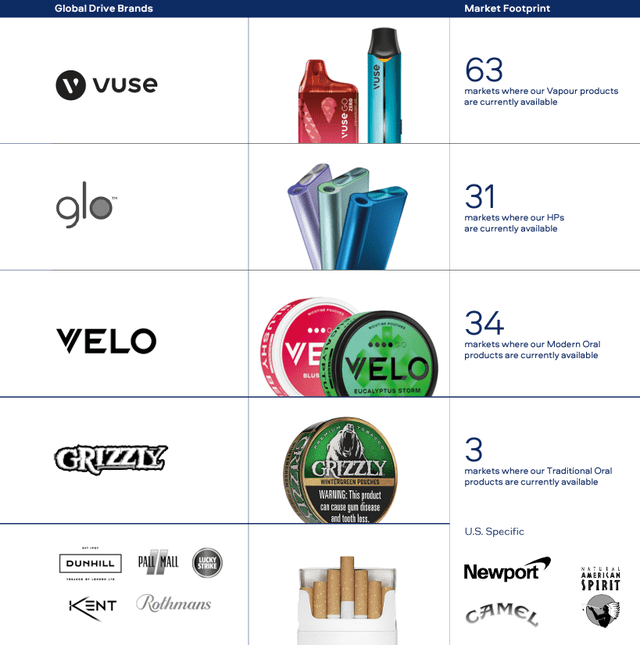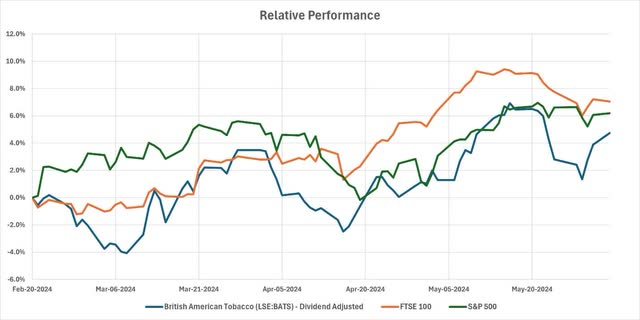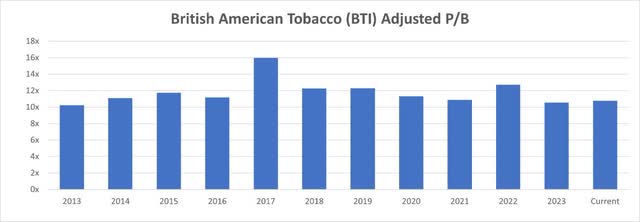mariusFM77
Introduction
British American Tobacco (NYSE:BTI) (OTCPK:BTAFF) continues to be an investor’s favorite, mainly due to the staple nature of the business, the inexpensiveness of the stock, and the high dividend yield it offers. There is a strong bullish consensus on the stock.
I have a more contrarian view. Although BTI is a globally established provider of tobacco products, the business faces headwinds, especially impacting its core business, which currently generates more than 80% of revenue.
I published my initial coverage back in February with a more detailed business description and laid out the arguments in my thesis more clearly. This article will provide a brief description of the business, assess the necessary metrics for the thesis, and explain why the stock may not be as cheap as the market believes it to be, leading to my “Hold” rating.
Business Description
As I mostly do when I publish follow-up articles, I’ll briefly review the business description first.
British American Tobacco is one of the largest tobacco companies. Even if you are not a consumer, you may have heard of some of its brands such as Camel, Newport, and Kent. Cigarettes, called Combustibles, are by far the largest segment the company has with 83% of total revenue in December 2023. However, it is not the only business.
The second-largest segment is called New Categories, which is highlighted as the future of the business. This segment produces various types of non-combustible products such as tobacco-free battery-powered devices (vapour), electronic devices that heat consumables such as flavored nicotine products (heated products), and pouches containing high-purity nicotine, water, and other ingredients (modern oral). This segment accounted for 13% of sales in the most recent fiscal year.
Finally, the traditional oral segment sells snus and snuff, which are smokeless tobacco products that are snorted or consumed orally. This segment generated only 4% in fiscal year 2023.
Some of the company’s brands can be seen below.
Stock Performance and Q2 Earnings
Let’s see how the stock performed since the end of February when I published my article. The stock performance of BTI is adjusted for dividends, as the dividend yield is a big part of shareholder returns for this company.
During this period, the stock slightly underperformed the broader market. The adjusted return was 4.7%, while Vanguard FTSE Europe ETF (VGK) and S&P 500 (SPY) surged 7% and 6.2%, respectively.
BTI typically releases its half-year pre-close results in June and a more detailed half-year report including financials a month later. On the 4th of June (which is when this article was written), the company released its first-half pre-close results. It does not include financials but gives us interesting insights.
Management says that the first half came in line with expectations, and they are on track to deliver the fiscal year 2024 guidance. There are three main areas highlighted by the management.
The first is that the core combustibles business continues to deliver, although there are macroeconomic pressures. Management mentions that the combustibles industry volume is down 9% YTD as consumers remain stretched.
Secondly, investments in New Categories continue. The company maintained global value share leadership with 41.1% in key markets. These gains were mostly in the Americas (excluding the US) and Europe, which offset the decline in the US. The company continues to call for more appropriate regulation for the use of some of its products. Additionally, the company keeps introducing new products in this segment.
Last but not least, management mentioned strong cash generation and the monetization of their ITC stake, enabling the share buy-back program.
These remarks show that the company continues to be a strong cash generator, which is used to return value to shareholders and invest more in the New Categories segment. Management expects low single-digit revenue growth and a 3% decline in the global tobacco industry volume.
Tracking The Initial Thesis
My initial thesis for a “Hold” rating included three main arguments. Slow transformation to a smoke-free world, the deterioration of the core business, and the sustainability of the dividend. Let’s review each separately.
Smoke-Free Transformation
This remains the main bull thesis. BTI is one of the largest players producing smokeless tobacco products, which consist of some products in new categories and traditional oral.
A Better Tomorrow initiative introduces the vision to build a smokeless world, migrating consumers from cigarettes to smokeless alternatives. This is a clear aim laid out by the company. With this initiative, the company targets that 50% of its revenue will come from non-combustible products by 2035.
The company also focuses on reducing harm, which is a public health strategy that reduces the negative health impact of smoking. This strategy is in line with the A Better Tomorrow initiative. Both of these strategies highlight that the company’s priority is the smokeless future and getting ready for it.
In 2023, sales in New Categories grew by 12%, while Traditional Oral and Combustibles declined by 3.4% and 6.4%, highlighting the company’s strategic direction.
Deteriorating Core Business
While the non-combustible side of the business seems to be growing and receiving investments, the core business fundamentals are deteriorating. As mentioned above, combustibles sales declined by 3.4% in fiscal year 2023. Half-year 2024 results are not out yet, but this will be something to track.
There are two main trends we need to talk about. The global popularity of cigarettes and regulatory changes.
First of all, according to the Federal State Commission, the long-term trend for the number of cigarettes sold in the United States has been declining. There are many non-profit organizations such as WHO that are pushing for regulations and pressuring tobacco companies to sell fewer cigarettes and to transform into healthier options. The company itself accepts that cigarettes will become a thing of the past.
This thesis is also supported by recent regulation developments from all around the world. The UK recently passed a bill that bans anyone born after 2009 from buying cigarettes. On the other side of the Atlantic, the US ban on menthol cigarettes seems to be being pushed to after the election. However, the risk of a ban still exists.
Dividend Sustainability
At the time of this article’s writing, BTI stock provides a dividend yield of 9.33%. This is very important to many investors. This high dividend yield ensures that BTI shows up on investment screens for investors and funds specifically interested in collecting dividends. That is why I think it is important to assess its sustainability.
In my previous analysis, I modeled the expected cash earnings of the company for the upcoming 5 years. I compared those with the financial obligations that the company will have to pay for. These financial obligations include dividends.
In that model, we saw that there was little buffer between the cash at hand and these financial obligations, putting dividends at risk. However, the company started monetizing its ITC stake. BTI currently owns 21.6% of ITC, which is valued at $13.3 billion based on the current market value of ITC.
Because of this monetization, I believe the dividend risk is close to none, and the balance sheet is strong. The sustainability of the dividend seems not worthy of tracking anymore.
The Market Does Not Expect Operational Improvements
BTI is an interesting idea to a lot of investors thanks to its high dividend yield and the stock being seemingly cheap. When running a traditional DCF model, I also calculate a handsome upside. The high dividend yield could also be considered evidence of cheapness, as the company can return more capital to its investors compared to the stock price.
However, a DCF model alone is rarely enough to understand the attractiveness of a price. Using the historical price-to-book allows us to understand how the stock was priced before and get insights into how the market may price the company in the future.
The adjusted price-to-book multiple shows that the stock always traded between the 10x-12x adjusted P/B range, with a few exceptions. Currently, the stock trades at 10.8x adjusted P/B.
The market doesn’t seem to believe that this company can revolutionize its business to generate more earnings on its assets in the near future. I agree with this assessment, mainly because of the fundamental developments we discussed in the “tracking the thesis” section.
Conclusion
British American Tobacco is one of the largest, leading tobacco companies in the world. Its brands are widely known, and the company has a good positioning to invest in non-combustibles. However, at the same time, the core business struggles.
Cigarette sales are still the largest segment, which faces demand issues and regulatory headwinds. The growth in non-combustibles is apparent, but it does not seem enough to offset the decline in the core business.
The stock appears cheap; however, it always appears cheap. The historical adjusted price-to-book shows that the stock was never priced for operational improvements that would lead to higher return on assets in the last decade. Currently, the multiple is within the historical range.
That is why I maintain my “Hold” rating for British American Tobacco. I believe investors should have a second look at alternative investment opportunities before investing in this company.
Editor’s Note: This article discusses one or more securities that do not trade on a major U.S. exchange. Please be aware of the risks associated with these stocks.


















